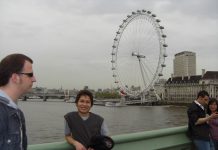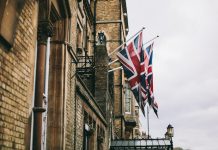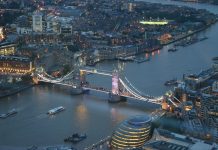
ในยุคกลางรัฐสภาได้เริ่มวิวัฒนาการเป็นสถาบันอย่างที่เป็นอยู่ทุกวันนี้ต้นกำเนิดของรัฐสภา
ในรูปแบบปัจจุบันสามารถย้อนกลับไปถึงสภาที่ปรึกษาของกษัตริย์อันประกอบด้วยขุนนาง
หรือชนชั้นผู้ดีและผู้นำคริสตจักรที่สำคัญๆ
ในช่วงเวลาก่อนปี ค.ศ. 1215 อังกฤษไม่มีตัวบทกฎหมายที่จะจำกัดอำนาจกษัตริย์
ได้มากนัก ในปี ค.ศ. 1215 กลุ่มขุนนางของพระเจ้าจอห์นได้บีบบังคับให้พระองค์ยอมรับข้อ
เรียกร้องหลายอย่าง ซึ่งส่งผลให้มีกฎบัตรว่าด้วยสิทธิ เรียกว่า แม็กนาคาร์ตา (ซึ่งมีความหมาย
ว่า มหากฎบัตร) มหากฎบัตรแม็กนาคาร์ตาเป็นรากฐานของความคิดที่ว่าแม้กษัตริย์เองก็ต้อง
อยู่ภายใต้กฎหมายแม็กนาคาร์ตาได้ปกป้องสิทธิของชนชั้นขุนนางและจำกัดพระราชอำนาจของกษัตริย์ในการเรียกเก็บภาษี หรือเปลี่ยนแปลงแก้ไขกฎหมาย โดยที่ในอนาคตกษัตริย์จะต้องให้ขุนนางของพระองค์มีส่วนร่วมพิจารณาตัดสินด้วย
ในอังกฤษจะมีการเรียกประชุมรัฐสภาเมื่อกษัตริย์ทรงต้องการที่จะปรึกษาหารือกับบรรดา
ขุนนาง โดยเฉพาะเกี่ยวกับการเรียกเก็บภาษีเพื่อหาเงินจำนวนผู้เข้าประชุมรัฐสภได้เพิ่ม
สูงขึ้น ต่อมาจึงได้มีการจัดแยกรัฐสภาออกเป็นสภาสองส่วน คือ สภาสูงหรือสภาขุนนางซึ่ง
เป็นที่นั่งของขุนนางหรือผู้ดีชั้นสูง เจ้าของที่ดินผู้มีอำนาจและพระสังฆราชส่วนสภาล่างหรือ
สภาสามัญนั้นประกอบด้วยอัศวินซึ่งปกติคือพวกเจ้าของที่ดินขนาดเล็กและคนมั่งมีจาก
เมืองเล็กเมืองใหญ่ที่ได้รับเลือกให้เข้ามานั่งในสภาสามัญเวลานั้นมีประชาชนเพียงส่วนน้อย
ที่สามารถเข้าร่วมในการเลือกตั้งสมาชิกสภาสามัญได้
ในสก็อตแลนด์ได้มีการพัฒนารัฐสภาในรูปแบบเดียวกัน แต่ประกอบด้วยสภาสามส่วน เรียก
ว่า เอสเตท (Estates) คือ สภาขุนนาง สภาสามัญ และสภาบาทหลวง
ในช่วงเวลานี้ยังได้มีการพัฒนาระบบกฎหมายด้วยและเริ่มมีการกำหนดหลักการให้ผู้พิพากษา
มีอำนาจที่ไม่ขึ้นอยู่กับรัฐบาลผู้พิพากษาในอังกฤษได้พัฒนา ‘กฎหมายจารีตประเพณี’ โดย
อาศัยกฎหมายหรือหลักเกณฑ์ที่มีมาก่อน (คือว่าตามการตัดสินในคดีความครั้งก่อนๆ) และ
ประเพณีในสก็อตแลนด์ได้มีการพัฒนาระบบกฎหมายแตกต่างกันไปเล็กน้อย โดยการ ‘จัดทำ
ไว้เป็นระบบหมวดหมู่’ (คือ จารึกไว้เป็นประมวลกฎหมาย)
Legal and political changes
In the Middle Ages, Parliament began to develop into the institution it is today.
Its origins can be traced to the king’s council of advisers, which included important
noblemen and the leaders of the Church.
There were few formal limits to the king’s power until 1215. In that year, King
John was forced by his noblemen to agree to a number of demands. The result
was a charter of rights called the Magna Carta (which means the Great Charter).
The Magna Carta established the idea that even the king was subject to the law.
It protected the rights of the nobility and restricted the king’s power to collect
taxes or to make or change laws. In the future, the king would need to involve his
noblemen in decisions
In England, parliaments were called for the king to consult his nobles, particularly
when the king needed to raise money. The numbers attending Parliament
increased and two separate parts, known as Houses, were established. The
nobility, great landowners, and bishops sat in the House of Lords. Knights, who
were usually smaller landowners, and wealthy people from towns and cities
were elected to sit in the House of Commons. Only a small part of the population
was able to join in electing the members of the Commons.
A similar Parliament developed in Scotland. It had three Houses, called Estates:
the lords, the commons, and the clergy.
This was also a time of development in the legal system. The principle that
judges are independent of the government began to be established. In England,
judges developed ‘common law’ by a process of precedence (that is, following
previous decisions) and tradition. In Scotland, the legal system developed
slightly differently and laws were ‘codified’ (that is, written down).







